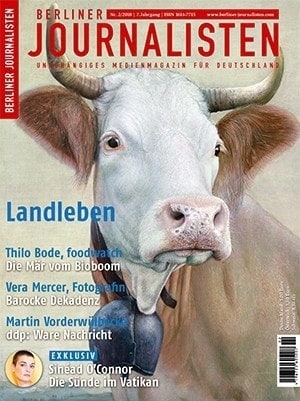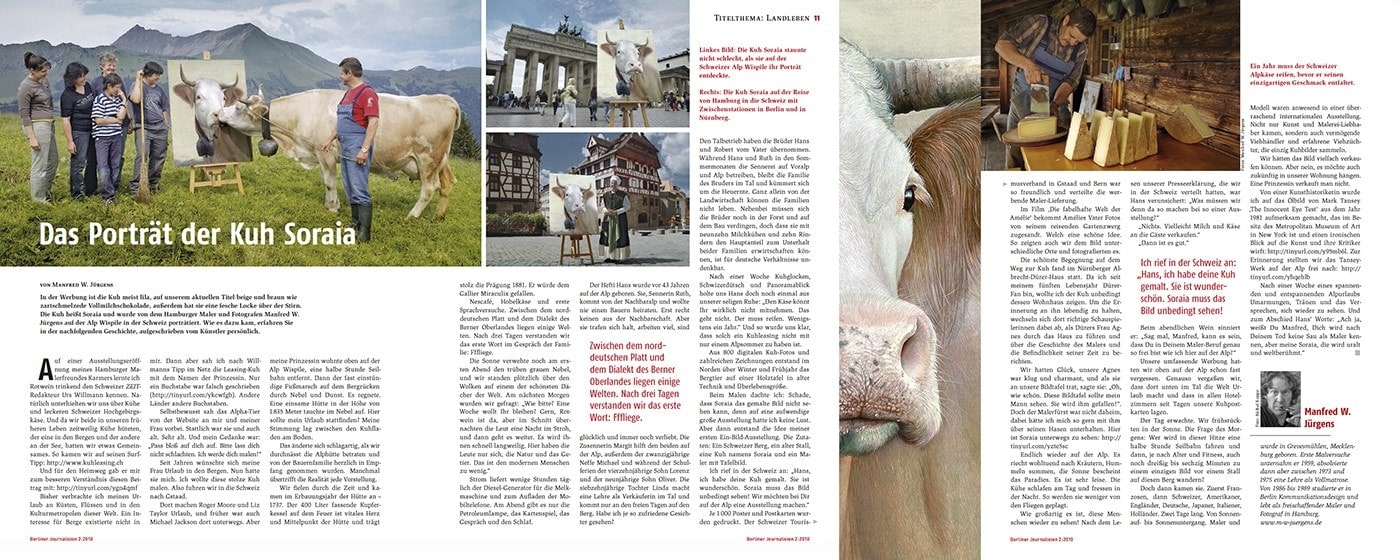
In advertising, the cow is usually purple, on our current title beige and brown like tenderly melting milk chocolate, also has a nice curl on the forehead. The cow is called Soraia and was portrayed by the painter and photographer Manfred W. Juergens on the Alp Wispile in Switzerland. How it came about, you will learn in the following story, written down by the artist himself.
At an exhibition opening of my Hamburg painter friend Karmers, I got to know the Swiss editor of the weekly paper DIE ZEIT Urs Willmann. Of course, we talked about cows and delicious Swiss high mountain cheese. And since we were both custodians in our past lives, one in the mountains and the other by the sea, we had something in common. So, we came to his surf tip: www.kuhleasing.ch. So far, I have spent my holidays on coasts, rivers and in the cultural metropolises of this world. An interest in mountains did not exist in me. But then, according to Willmann's tip in the net, I saw the leasing cow with the name of the princess. Only one letter was misspelled. Other countries other letters.
Self-confidently, the alpha animal from the website looked past me and my wife. Stately she was and also old. Very old. And my thought was, 'Just take care of yourself. Please do not let slaughter you. I will paint you!' For years my wife wished holidays in the mountains. Now she had me. I wanted to paint this proud cow. So, we drove to Switzerland to Gstaad.
That's where Roger Moore and Liz Taylor go on holiday, and Michael Jackson used to be there too. But my princess lived on top of Alp Wispile, a half-hour cable car away. Then the almost one-hour walk on the ridge through fog and haze. It rained. A lonely hut at the height of 1,835 meters emerged in the fog. Here should my vacation take place? My mood was between the cow dung on the ground.
That changed abruptly when we entered the alpine hut drenched and welcomed by the peasant family. Sometimes reality surpasses any idea. We fell through time and arrived in the year of construction of the hut – 1737. The 400 liter copper kettle on the fire is the vital heart and center of the hut and proudly bears the coinage 1881. He would like the Gaul Miraculix.
Nescafé, sliced cheese and first language tests. Between the North German Platt and the dialect of the Bernese Oberland are some worlds. After three days we understood the first word in the conversation of the family: Fffly
The sun was blowing the dull gray fog the first evening, and we suddenly stood above the clouds on one of the most beautiful roofs in the world. The next morning, we were asked, 'Excuse me, you want to stay a week? With pleasure, red wine is here, but on average the people spend the night in the straw, and then it goes on. They get bored quickly. Here, people only have themselves, nature and animals - that is too little for modern man.' Electricity is supplied for a few hours daily by the diesel generator for the milking machine and for charging the mobile phones. In the evening, there is only the kerosene lamp, the card game, the conversation and sleep.
Hefti Hans was born 43 years ago on the alp. She, dairymaid Ruth, comes from the neighboring alp and never wanted to marry a farmer. Especially not one from the neighborhood. But they just met, work a lot, are happy and still in love. Colleague Margit helps the two of them on the alp, as well as twenty-year-old nephew Michael and, during school holidays, fourteen-year-old son Lorenz and nine-year-old son Oliver. The seventeen-year-old daughter Linda does an apprenticeship as a saleswoman in the valley and only gets on the mountain on her days off. Have I ever seen such happy faces?
The valley operation, the brothers Hans and Robert have taken over from the father. While Hans and Ruth run the dairy on Prealp and Alp in the summer months, their brother's family stays in the valley and takes care of the hay harvest. The families cannot live entirely on agriculture alone. Incidentally, the brothers still have to get involved in forestry and construction, but the fact that they can earn the lion's share to support both families with nineteen dairy cows and ten cattle is unthinkable by German standards.
After a week of cow bells, Swiss-German and panoramic views Hans brought us yet again from our blissful calm: 'You really cannot take the cheese with you, that's impossible, it has to mature, at least a year.' And so it became clear to us that such a cow-leasing is not possible with just one alpine summer. From 800 digital cow photos and numerous drawings, the mountain animal was created in the north over winter and spring on a wooden board in traditional technique and life-size.
While painting, I thought: Too bad that Soraia cannot see the painted picture, because I had no desire for a lavish large exhibition. But then came the idea of my first one-image exhibition. The ingredients: A Swiss mountain, an old stable, a cow named Soraia and a painter with panel painting.
I called in Switzerland: 'Hans, I painted your cow. She is beautiful. Soraia must see the painting! We would like to make an exhibition on your Alp. ' 1,000 posters and postcards were printed. The Swiss Tourism Association in Gstaad and Bern was so friendly and distributed the advertising painter delivery.
In the movie 'The Fabulous World of Amélie', Amélie's father receives photos of his traveling garden gnome. What a nice idea. So, we showed the painting different places and photographed it.
The most beautiful encounter on the way to the cow took place in the Nuremberg Albrecht Duerer House. Since I am a Duerer fan since I was five years old, I really wanted to show the cow his home. In order to keep the memory of him alive, real actresses are guiding through the house as Duerer's wife Agnes and telling about the painter's history and the mood of his time.
We were lucky, our Agnes was smart and charming, and when she came to our panel, she said, 'Oh, how nice. This picture should be seen by my husband. He would like her! ' But the painter lord was not at home, so I would have loved to talk to him about his rabbit.❯ Here you can see Soraia on the way to the Gstaad.
Finally back on the alp. It smells soothing to herbs, humble bumblebees, the sun shines on paradise. It is very quiet. The cows sleep during the day and eat at night. So they are less plagued by the flies.
How great it is to see these people again! After reading our press release, which we had distributed in Switzerland, Hans was unsure: 'What do we have to do there at such an exhibition?' 'Nothing. Maybe selling milk and cheese to the guests.' 'Then it's good.'
While drinking wine in the evening he muses: 'Tell me, Manfred, can it be that you are as free in your painting profession as I am here on the alp?' We had almost forgotten about our extensive advertising on the Alp. Likewise, we forgot that down there in the valley the world makes vacation and that in all hotel rooms for days our cow postcards were.
The day awakened. We had breakfast in the sun. The question of the morning: Who will drive in this heat half an hour cable car and then, depending on age and fitness, hiking thirty to sixty minutes to a single picture in front of a stable on this mountain?
But then they came. First French, then Swiss, American, English, German, Japanese, Italian, Dutch. For two days. From sunrise to sunset. Painter and model were present in a surprisingly international exhibition. Not only art and painting lovers came, but also wealthy cattle dealers and experienced ranchers who collect only cow pictures.
We could have sold the picture many times. But no, it also wants to hang in our apartment in the future. You do not sell a princess.
An art historian drew my attention to the 1981 oil painting of ❯ Mark Tansey 'The Innocent Eye Test' owned by the Metropolitan Museum of Art in New York, which casts ironic views on art and its critics. As a reminder, we recreated the Tansey oeuvre on the alp.
After a week of exciting and relaxing alpine holidays, hugs, tears and the promise to see each other again. And goodbye Hans' words: 'Oh yes, you know Manfred, no one will know you after your death as a painter, but my Soraia, she will become age-old and world famous.'
